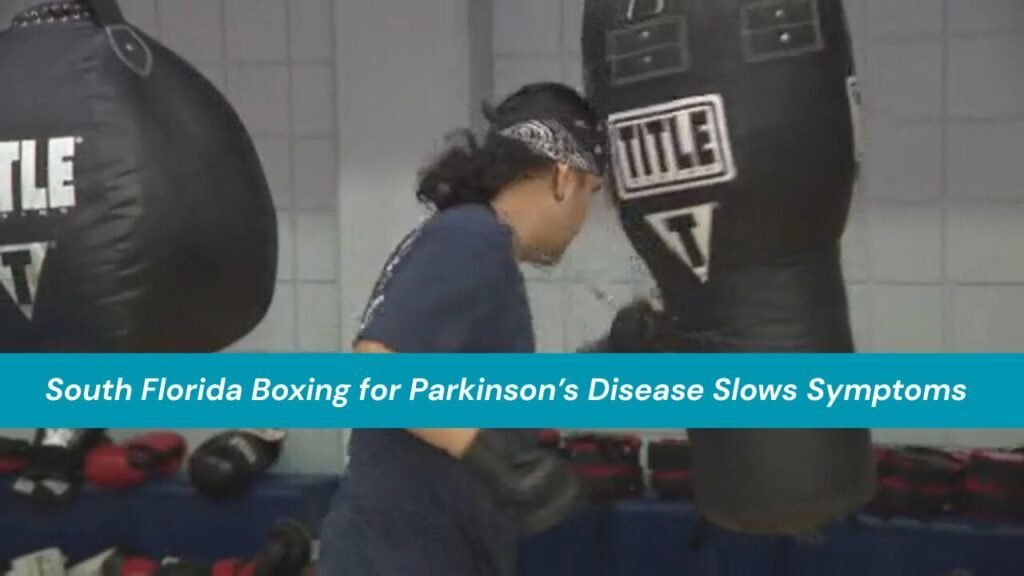When Juan Rodriguez first received his Parkinson’s disease diagnosis, his world changed overnight. The condition stole from him the simple joys and abilities that most people take for granted. Walking across the room felt like climbing a mountain. Stretching his body was almost impossible. Even pulling on socks each morning became a task so frustrating that it left him exhausted before the day even began. Yet today, Rodriguez enters a gym in North Miami with his head high and boxing gloves in hand. He moves across the floor with confidence, throws crisp punches at a heavy bag, and leaves each session stronger than when he arrived. The turnaround did not happen by chance. It came through a unique community program offering boxing for Parkinson’s disease, an approach that is transforming lives across South Florida and beyond.
In this feature, we’ll explore how boxing is being used as therapy, why it works, what science says about it, and how people living with Parkinson’s can join classes to fight back against their symptoms one punch at a time.
The Rise of the “Box with a Heart” Program in South Florida
The story of South Florida’s boxing initiative for Parkinson’s begins at the Michael-Ann Russell Jewish Community Center (MAR-JCC) in North Miami. The program, known as Box with a Heart, is an affiliate of the internationally recognized Rock Steady Boxing organization. Its founder, Jennifer Enslein, was not a professional trainer or medical researcher. She was a wife desperate to find a solution when her husband was diagnosed with Parkinson’s disease. Nine years ago, Enslein began with a simple idea: if exercise could slow down the condition, why not try something dynamic, challenging, and empowering like boxing? She started small, with just a dozen participants. Word spread, doctors took notice, and the classes quickly grew. Today, nearly 300 South Florida residents with Parkinson’s participate regularly, making it one of the largest Rock Steady affiliates in the nation.
Enslein often describes the program as her “life’s mission.” Watching her husband and hundreds of others regain strength, confidence, and independence confirmed what she believed from the beginning: exercise can be medicine. Unlike traditional gyms, the Box with a Heart program is tailored specifically to Parkinson’s patients. Sessions are non-contact, meaning no one actually punches another person. Instead, they train on heavy bags, use footwork drills to improve balance, perform call-and-response voice exercises to strengthen speech, and push themselves through carefully designed routines that address the very symptoms Parkinson’s takes away. For Enslein, the most rewarding part is seeing members walk in with uncertainty and leave with smiles, energy, and hope.
Real Stories of Strength and Transformation
The impact of boxing for Parkinson’s is best understood through the people who live it every day. Rodriguez, once unable to stretch or walk across the room, now proudly declares that he can “do everything.” His transformation did not erase his diagnosis, but it gave him control over his life again. The discipline of wrapping his hands, stepping into the gym, and punching through a workout restored his confidence in ways medication alone could not achieve.
For Jennifer Enslein, the founder, the program is deeply personal. Her husband’s diagnosis could have left her paralyzed with fear and grief. Instead, she channeled that energy into creating a space where people come not just to exercise but to connect, to laugh, to challenge themselves, and to rediscover purpose. Every time she watches a class of dozens of boxers—some in their seventies or eighties push themselves through combinations and cheer each other on, she sees the embodiment of resilience.
There is also the contribution of Francisco Palacios, a retired professional boxer who once fought for world titles. Today, he volunteers as a trainer in the South Florida program. For Palacios, stepping into the gym is no longer about chasing belts or recognition. It is about giving back. He explains that boxing combinations jab, cross, hook, uppercut are not just punches but tools to retrain the brain. Each movement challenges balance, timing, and coordination. For people with Parkinson’s, those skills can mean the difference between falling in the kitchen and moving safely through the day. Palacios says he sees miracles every week, not because symptoms disappear, but because people discover that they are stronger than their disease.
Why Boxing Works for Parkinson’s
To the casual observer, the idea of putting people with a movement disorder into a boxing gym might seem counterintuitive. Yet the science behind it makes sense. Parkinson’s disease primarily affects the nervous system, disrupting the brain’s ability to produce dopamine, a chemical essential for controlling movement. This leads to stiffness, tremors, slow movements, balance problems, and sometimes difficulties with speech. While medications like levodopa help replace dopamine, they do not cure the disease. Exercise, however, offers something different. It does not just treat symptoms in the moment—it may slow down progression by encouraging the brain to form new pathways.
Boxing is particularly powerful because it is intense, complex, and full-body. Unlike walking on a treadmill or lifting weights in isolation, boxing requires coordination between the hands, feet, eyes, and voice. Each drill challenges both the body and the mind. Stepping forward with a jab, pivoting on the feet, and calling out combinations engage multiple brain regions simultaneously. This constant stimulation encourages neuroplasticity, the brain’s ability to rewire itself. Over time, that can help people compensate for the loss of dopamine-producing cells.
Physically, boxing improves balance and coordination, reduces rigidity in muscles, and strengthens posture. The act of striking a bag with power can increase flexibility and confidence. Many programs also integrate stretching and mobility exercises that directly target stiffness, one of Parkinson’s most debilitating symptoms. Beyond movement, boxing classes often include loud vocal shouts during drills, helping participants strengthen their voices and fight the common symptom of speech becoming soft and hard to hear.
The psychological impact is equally important. Group classes foster camaraderie and accountability. People who once felt isolated by their diagnosis find themselves part of a community that celebrates effort rather than perfection. This sense of belonging often translates into better mood, reduced depression, and renewed motivation to stay active.
What the Research Shows
Scientific studies are increasingly validating what Parkinson’s patients and their families already know. The Parkinson’s Foundation highlights boxing as one of the most beneficial exercise programs for people with Parkinson’s, pointing to improvements in mobility, strength, and emotional well-being. Doctors across the United States now routinely recommend non-contact boxing as part of a treatment plan.
A 2024 study published on arXiv provided even more compelling evidence. Researchers tracked Parkinson’s patients who participated in Rock Steady Boxing over an eight-week period. The results showed significant improvements in depressive symptoms, as measured by the Beck Depression Inventory. Motor skills, balance, and mood also improved. The study concluded that consistent participation in high-intensity boxing training not only reduced symptoms but enhanced overall quality of life.
Other research supports similar findings. High-intensity exercise has been linked to slower disease progression, possibly due to increased production of brain-derived neurotrophic factor (BDNF), a protein that supports healthy brain cells. Group programs also encourage long-term adherence, which is critical because Parkinson’s requires ongoing management rather than short-term fixes.
The Global Reach of Rock Steady Boxing
While the South Florida program is one of the most vibrant, it is not alone. Rock Steady Boxing began in Indianapolis in 2006 and has since grown into a global network with more than 900 affiliates across the United States and abroad. Each affiliate operates independently but follows the same principles: non-contact boxing, certified coaches, and a commitment to empowering Parkinson’s patients.
In Florida alone, the movement has expanded rapidly. The Florida Movement Therapy Centers in Boca Raton and Boynton Beach host Rock Steady programs, offering classes specifically designed for people at all stages of the disease. These facilities emphasize that boxing is for everyone—whether you are newly diagnosed, advanced in your condition, or even confined to a chair. Exercises are adapted to each individual, ensuring safety while still challenging participants to push their limits.
The Michael-Ann Russell JCC in North Miami remains one of the largest hubs, but it is joined by other Jewish Community Centers and gyms that see the value of offering Rock Steady Boxing. Neurologists in the region increasingly refer patients to these programs, recognizing that lifestyle changes play an essential role in managing the disease.
To find classes near you, the Rock Steady Boxing website provides a directory of affiliates across the country and worldwide.
How to Get Started in South Florida
For those interested in joining, the first step is usually a conversation with a neurologist or physical therapist. Most physicians are supportive of exercise programs and can help determine if boxing is appropriate based on individual health and mobility. Once cleared, people in South Florida have several options.
The Box with a Heart program at MAR-JCC is open to new members, offering classes throughout the week. Family members are often welcome to observe or even participate in some of the conditioning. The Florida Movement Therapy Centers also provide structured boxing sessions and have trained staff experienced in neurological conditions. In addition, other local fitness centers and JCCs are beginning to add Rock Steady affiliates, making the program more accessible than ever.
Those outside South Florida can use the Rock Steady Boxing directory to locate programs near them. If none exist locally, some affiliates even offer virtual training sessions, allowing people to participate from home. It is a testament to how much the program has grown in popularity and demand.
Frequently Asked Questions
What exactly is boxing for Parkinson’s disease?
It is a specialized, non-contact exercise program based on boxing training. Participants work with bags, footwork drills, stretching, and voice exercises. The goal is to address the core symptoms of Parkinson’s balance problems, stiffness, slow movements, and speech difficulties through engaging and challenging workouts.
Is boxing safe for all stages of Parkinson’s?
Yes, when supervised by certified Rock Steady Boxing coaches. The exercises are scaled to match each participant’s abilities. Beginners might focus on simple footwork and stretches, while advanced members perform complex punch combinations and conditioning. Even individuals with limited mobility can benefit from modified drills, including seated exercises.
How often should someone train to see results?
Consistency matters more than intensity. Most neurologists and trainers recommend attending three to four classes per week. Regular participation ensures that improvements in strength, balance, and coordination are maintained and built upon over time.
Can boxing actually slow the progression of Parkinson’s?
While there is no cure, research indicates that vigorous exercise, particularly structured programs like Rock Steady Boxing, may slow the progression of symptoms. By promoting neuroplasticity, strengthening the body, and enhancing mood, boxing helps patients maintain independence longer and enjoy a higher quality of life.
What makes the South Florida program unique?
The combination of size, community, and leadership sets it apart. With nearly 300 members, passionate volunteers like Francisco Palacios, and a founder like Jennifer Enslein who turned her family’s struggle into a movement, the program has become both a support group and a symbol of resilience for the region.
Conclusion
Parkinson’s disease can feel like a relentless opponent, slowly chipping away at strength, confidence, and independence. Yet in South Florida, a growing community of fighters proves that the disease does not get the final word. Programs like Box with a Heart at MAR-JCC, alongside Rock Steady affiliates across the state, empower patients to face each day with determination. With gloves on and hearts strong, they are reclaiming their lives.
As Juan Rodriguez demonstrates every time he laces up his gloves, Parkinson’s may knock you down, but with the right tools and the right community, you can always get back up.




